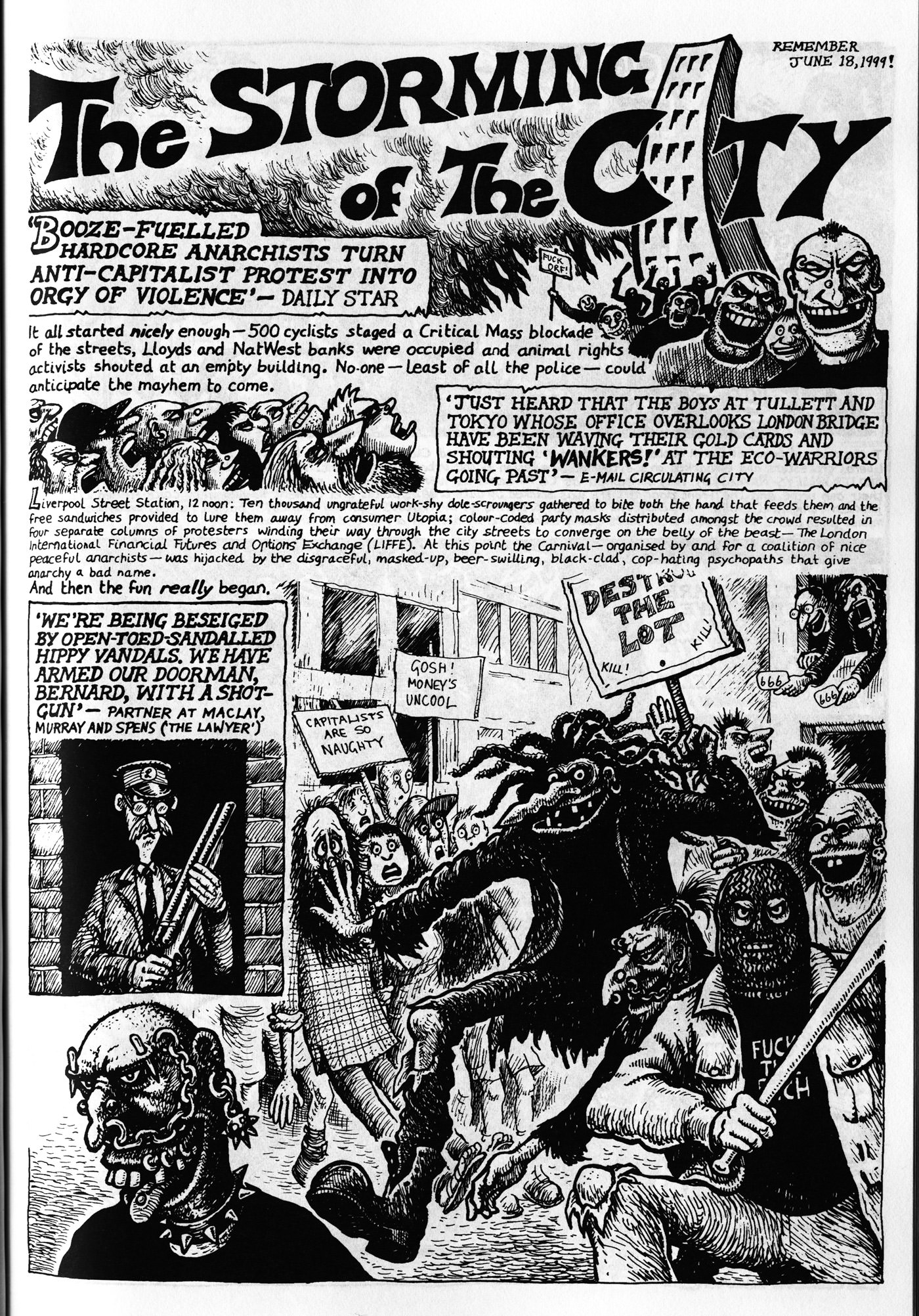When nationalist billionaires attempt to pose as rebels against the global elite, it’s important to remember all the genuine grassroots movements that pose a real threat to those institutions. In that spirit, today we recall how eighteen years ago, demonstrators shut down London’s financial district in protest against the injustices of global capitalism.
Whatever rhetoric he spews about “globalism,” Donald Trump is not an opponent of capitalist globalization, but one of its foremost practitioners, updating it for the 21st century. In contrast with his opportunism, anarchists have always maintained a principled position against so-called “free trade,” coordinating with others around the world to resist its prerogatives and demonstrate other ways of relating to one another and circulating resources. One of the most important clashes in the history of these movements took place on June 18, 1999, in downtown London.
An outgrowth of the free festival movement and the British Earth First! and Reclaim the Streets groups, the Carnival against Capitalism was scheduled to coincide with the 24th summit of the G8 in Birmingham, England and coordinated anti-capitalist demonstrations in forty different countries. It was one of the Global Days of Action called by the People’s Global Action network, which grew out of a series of international meetings initiated by the Zapatista Army of National Liberation (EZLN) in Chiapas, Mexico.
June 18, 1999.
Participants distributed a paper, Evading Standards, expressing their critique of capitalism in the format of the London newspaper, The Evening Standard—the nearest thing to hacking a website in the era of print media. Reclaim the Streets also produced a 32-page pamphlet, Squaring up to the Square Mile, identifying the functions (and locations!) of all the institutions, banks, corporate headquarters, and watering holes in downtown London that were integral to the functioning of globalized capitalism. A new version appeared for the 2009 G20 summit in London.
On June 18, 1999, thousands of demonstrators converged at the Liverpool Street train station. Organizers distributed masks in four different colors and the participants broke up into four different marches in order to divide and confuse police; a spontaneous fifth march emerged, as well as a Critical Mass composed of hundreds of bicyclists. The marches converged on the London International Financial Futures Exchange (LIFFE), where they hung banners, set off a fire hydrant to symbolize the liberation of the river beneath London’s streets, adorned the walls with graffiti, disabled surveillance cameras, and set up sound systems for DJs and punk bands to perform. A raucous afternoon of dancing, exuberance, and street fighting followed, during which participants bricked up the front of the LIFFE building, broke in and trashed its ground floor, and nearly succeeded in destroying the London Stock Exchange itself. In response, police attacked the general public with tear gas and horse charges and ran over one demonstrator with a riot van, breaking her leg.

Afterwards, participants reflected that they had come very close to occupying the trading floor of the Stock Exchange. This is a reminder to bear in mind that sometimes our crazy plans succeed—and to prepare accordingly.
The events of June 18, 1999 set the stage for the historic demonstrations against the summit of the World Trade Organization in Seattle later that year. This catapulted the anti-capitalist movement—which timid journalists insisted on referring to as “anti-globalization”—into the public consciousness, contributing to the resurgence of anarchism at the beginning of the 21st century. For many years after the Carnival against Capitalism, no one was confused about who the real opponents of capitalist globalization were. These actions set a narrative that made it very difficult for nationalists to pose as rebels against the status quo. It took a decade and a half of successive waves of police repression to suppress these movements to such an extent that a demagogue like Trump could position himself as the foe of the global elite.
From our vantage point today, the Carnival against Capitalism is striking for its ludic, joyous character. It was confrontational, but it succeeded by drawing people together in lighthearted collective activity, contrasting sharply with the dour violence inflicted by humorless police. Today, when protracted state violence has forced social movements into a combative stance, we would do well to recall the inventive energy of those days—not to lose our way in a grim grudge match with fascists and the state, but to remember that our most important task is to engage with other people by demonstrating a more fulfilling way of living.
News coverage of June 18.
To illustrate the playful attitude of those times, we’ve tracked down a comic satirizing police violence and corporate media coverage of the June 18 protests, which appeared in the British radical print publication Schnews at the time. Today, when literalistic FBI agents and far-right trolls have rendered irony and caricature practically impossible, this comic appears as a vestige of a more innocent era. Enjoy!
